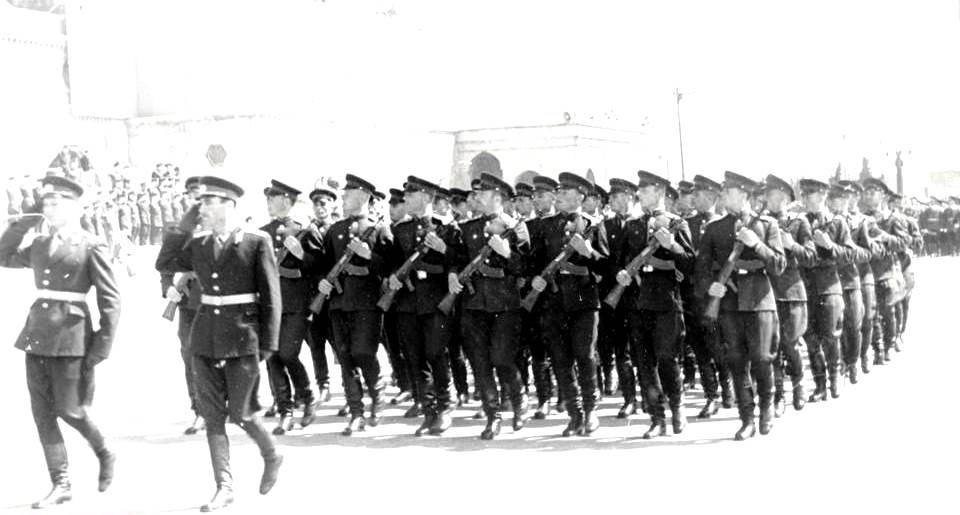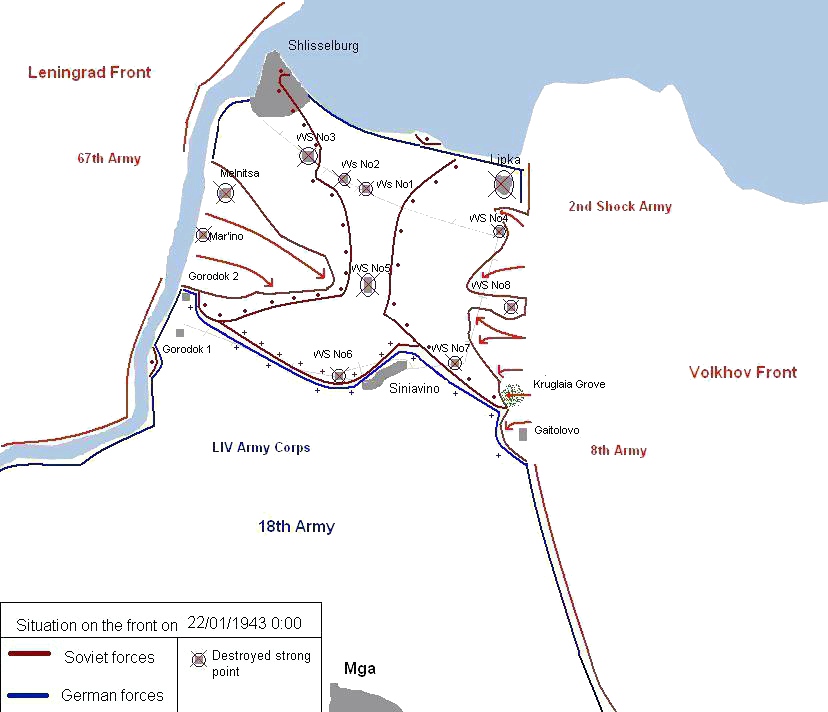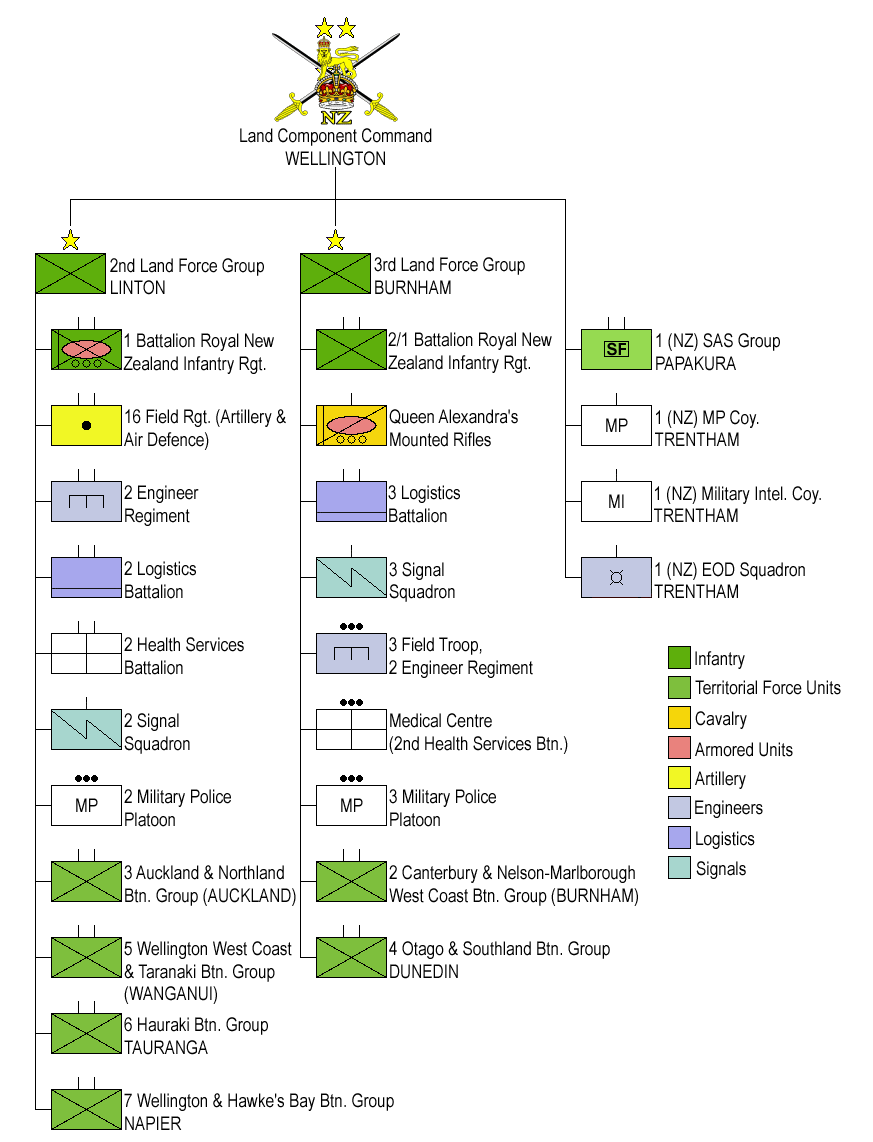|
376th Rifle Division (Soviet Union)
The 376th Rifle Division was raised in 1941 as an infantry division of the Red Army, and served for the duration of the Great Patriotic War in that role. It began forming in August 1941 in the Siberian Military District. It followed a very similar combat path to that of the 374th Rifle Division. It joined the fighting front in December with the new 59th Army along the Volkhov River and it continued to serve in the battles near Leningrad until early 1944. The division took horrendous casualties in the combat to create and hold open a passage to the 2nd Shock Army during the Lyuban Offensive and was itself partly or fully encircled at several times during this dismal fighting. The division finally left this region as it advanced during the Leningrad–Novgorod Offensive in January 1944 and in July won a battle honor in the liberation of Pskov, while its 1250th Rifle Regiment was awarded the Order of the Red Banner. In October the 376th as a whole would also receive the Red Banner ... [...More Info...] [...Related Items...] OR: [Wikipedia] [Google] [Baidu] |
Red Army
The Workers' and Peasants' Red Army (Russian: Рабо́че-крестья́нская Кра́сная армия),) often shortened to the Red Army, was the army and air force of the Russian Soviet Federative Socialist Republic and, after 1922, the Union of Soviet Socialist Republics. The army was established in January 1918. The Bolsheviks raised an army to oppose the military confederations (especially the various groups collectively known as the White Army) of their adversaries during the Russian Civil War. Starting in February 1946, the Red Army, along with the Soviet Navy, embodied the main component of the Soviet Armed Forces; taking the official name of "Soviet Army", until its dissolution in 1991. The Red Army provided the largest land force in the Allied victory in the European theatre of World War II, and its invasion of Manchuria assisted the unconditional surrender of Imperial Japan. During operations on the Eastern Front, it accounted for 75–80% of casual ... [...More Info...] [...Related Items...] OR: [Wikipedia] [Google] [Baidu] |
Novokuznetsk
Novokuznetsk ( rus, Новокузнецк, p=nəvəkʊzˈnʲɛt͡sk; literally: "new smith's", cjs, Аба-тура, ''Aba-tura'') is a city in Kemerovo Oblast (Kuzbass) in south-western Siberia, Russia. It is the second largest city in the oblast, after Kemerovo. Population: It was previously known as ''Kuznetsk'' until 1931, and as ''Stalinsk'' until 1961. History Founded in 1618 by men from Tomsk as a Cossack '' ostrog'' (fort) on the Tom River, it was initially called Kuznetsky ostrog (). It became the seat of Kuznetsky Uyezd in 1622. Kuznetsk () was granted town status in 1689. It was here that Fyodor Dostoevsky married his first wife, Maria Isayeva (1857). Joseph Stalin's rapid industrialization of the Soviet Union transformed the sleepy town into a major coal mining and industrial center in the 1930s. It merged with Sad Gorod in 1931. In 1931–1932, the city was known as Novokuznetsk and between 1932 and 1961 as Stalinsk (), after Stalin. Climate Novokuznetsk has a fa ... [...More Info...] [...Related Items...] OR: [Wikipedia] [Google] [Baidu] |
190th Rifle Division (Soviet Union)
Nineteen or 19 may refer to: * 19 (number), the natural number following 18 and preceding 20 * one of the years 19 BC, AD 19, 1919, 2019 Films * ''19'' (film), a 2001 Japanese film * ''Nineteen'' (film), a 1987 science fiction film Music * 19 (band), a Japanese pop music duo Albums * ''19'' (Adele album), 2008 * ''19'', a 2003 album by Alsou * ''19'', a 2006 album by Evan Yo * ''19'', a 2018 album by MHD * ''19'', one half of the double album ''63/19'' by Kool A.D. * ''Number Nineteen'', a 1971 album by American jazz pianist Mal Waldron * ''XIX'' (EP), a 2019 EP by 1the9 Songs * "19" (song), a 1985 song by British musician Paul Hardcastle. * "Nineteen", a song by Bad4Good from the 1992 album '' Refugee'' * "Nineteen", a song by Karma to Burn from the 2001 album ''Almost Heathen''. * "Nineteen" (song), a 2007 song by American singer Billy Ray Cyrus. * "Nineteen", a song by Tegan and Sara from the 2007 album '' The Con''. * "XIX" (song), a 2014 song by Slipknot. ... [...More Info...] [...Related Items...] OR: [Wikipedia] [Google] [Baidu] |
310th Rifle Division (Soviet Union)
The 310th Rifle Division was a standard Red Army rifle division formed on July 15, 1941 in Kazakhstan before being sent to the vicinity of Leningrad, where it spent most of the war, sharing a similar combat path with its "sister", the 311th Rifle Division. The soldiers of the division fought until early 1944 to, first, hold open some sort of lifeline to the besieged city, then to break the siege and drive off the besieging German forces. They then participated in the offensive that drove Germany's Finnish allies out of the war. Finally, the division was redeployed to take the fight to the German heartland in the winter and spring of 1945. It ended the war north of Berlin with a very creditable combat record for any rifle division. Formation The 310th began forming in mid July 1941 in Kazakhstan in the Akmolinsk region of the Central Asia Military District. The personnel of the division were mostly Kazakhs at this time. Its order of battle was as follows: * 1080th Rifle Regiment * ... [...More Info...] [...Related Items...] OR: [Wikipedia] [Google] [Baidu] |
44th Rifle Division (Soviet Union)
The 44th ''Kievskaya'' of the Red Banner Rifle Division of Nikolay Shchors, or ''44th Kievskaya'' for short, was an elite military formation of the Soviet Union. Created during the beginnings of the Russian Civil War. It was destroyed during the Winter War, after being ordered to help the 163rd Infantry Division break a Finnish siege on the Raate road as part of the Special Rifle Corps 9th Army, together with the 54th Rifle Division. Afterwards it was levied and dissolved multiple times through out the 40's and 50's until its final dissolution in 1959. Early history Creation The unit is also famous for being the one of the first military formations out of which was formed the short-lived Ukrainian Soviet Army (November 30, 1918 – June 1, 1919). It was formed by the order no.6 of the Communist Party (Bolshevik) of Ukraine on September 22, 1918, as the 1st Insurgent Division along with the 2nd Insurgent Division. The 1st Insurgent Division was formed out of insurgent squads of ... [...More Info...] [...Related Items...] OR: [Wikipedia] [Google] [Baidu] |
4th Army (Soviet Union)
The 4th Army was a Soviet field army of World War II that served on the Eastern front of World War II and in the Caucasus during the Cold War. It was disbanded after the fall of the Soviet Union, with its divisions being withdrawn to Russia and disbanded. World War II First Formation The Fourth Army was created in August 1939 in the Belorussian Special Military District from the Bobruisk Army Group as an independent army. In September 1939, the Fourth Army took part in the Soviet invasion of Poland commanded by the future Marshal of Soviet Union V.I. Chuykov, the defender of Stalingrad. Its order of battle in that operation is listed here. Elements of the army, apparently 4th Battalion, 29th Light Tank Brigade, took part in the German–Soviet military parade in Brest-Litovsk on September 22, 1939. When the German invasion of the Soviet Union commenced on 22 June 1941, the Army was part of the Western Front and had the 28th Rifle Corps ( 6th Rifle Division and 42nd Rifle Div ... [...More Info...] [...Related Items...] OR: [Wikipedia] [Google] [Baidu] |
Volkhov River
The Volkhov (russian: Во́лхов) is a river in Novgorodsky and Chudovsky Districts of Novgorod Oblast and Kirishsky and Volkhovsky Districts of Leningrad Oblast in northwestern Russia. It connects Lake Ilmen and Lake Ladoga and forms part of the basin of the Neva. The length of the river is , and the area of its drainage basin is . The city of Veliky Novgorod, the towns of Kirishi, Volkhov and Novaya Ladoga, and the historically important village of Staraya Ladoga are located along the Volkhov. Etymology A number of etymologies, none universally accepted, have been proposed for the name of the river. In his ''Etymological dictionary of the Russian language'', Max Vasmer doubted some philologists' opinion that the river's name is related to the Finnish ''velho'' ("magician") or Russian ''volkhv'' ("pagan priest"). Geography The Volkhov flows out of Lake Ilmen north into Lake Ladoga, the largest lake in Europe. It is the second largest tributary of Lake Ladoga. It is ... [...More Info...] [...Related Items...] OR: [Wikipedia] [Google] [Baidu] |
288th Rifle Division
The 288th Rifle Division () was an infantry division of the Soviet Union's Red Army during World War II. Formed in the summer of 1941, the division was sent into combat on the Volkhov Front in the fall of that year. The division served in the area until early 1944 when the siege of Leningrad was ended and the 288th advanced into the Baltic states. The division spent the final months of the war blockading trapped German troops in the Courland Pocket before being disbanded in early 1946. History The 288th began forming on 13 July 1941 at Yaroslavl, part of the Moscow Military District, from reservists. Its basic order of battle included the 1012th, 1014th, and 1016th Rifle Regiments, as well as the 834th Artillery Regiment. The division was moved north within a month and in mid-August was assigned to the new 52nd Army, forming east of Leningrad in the swampy Volkhov area. The overstretched division held a front of 46 kilometers in the Volkhov area by mid-October. In early January ... [...More Info...] [...Related Items...] OR: [Wikipedia] [Google] [Baidu] |
Kirill Meretskov
Kirill Afanasievich Meretskov (russian: Кири́лл Афана́сьевич Мерецко́в; – 30 December 1968) was a Soviet military commander. Having joined the Communist Party in 1917, he served in the Red Army from 1920. During the Winter War of 1939–1940 against Finland, he had the task of penetrating the Mannerheim Line as commander of the 7th Army. He was awarded the title of Hero of the Soviet Union shortly afterwards. The NKVD arrested Meretskov at the start of invasion of the Soviet Union. Released two months later, he returned to command the 7th Army and later the Volkhov Front during the 1941–1944 siege of Leningrad. He commanded the Karelian Front from February 1944, notably the Petsamo–Kirkenes Offensive of October 1944. From April 1945 he was assigned to the Far East, where he commanded a front during the Soviet invasion of Japanese Manchuria. During the war he reached the rank of Marshal of the Soviet Union. [...More Info...] [...Related Items...] OR: [Wikipedia] [Google] [Baidu] |
Volkhov Front
The Volkhov Front (russian: Волховский фронт) was a major formation of the Red Army during the first period of the Second World War. It was formed as an expediency of an early attempt to halt the advance of the Wehrmacht Army Group North in its offensive thrust towards Leningrad. Initially the front operated to the south of Leningrad, with its flank on Lake Ladoga. First formation The Volkhov Front was formed on 17 December 1941 from the left wing of the Leningrad Front and elements of the Reserve of the Supreme High Command (''Stavka'' Reserve) during the conduct of the Tikhvin Offensive operation under the command of the Army General Kirill Meretskov, with General Grigory Stelmakh (former commander of the 4th Army) as Chief of Staff and Army Commissar of 1st rank A.I.Zaporozhets.Meretskov, On the service of the nation, Ch.6 Initially Sokolov's 26th Army (later 2nd Shock Army) and Galanin's 59th Armies were allocated to the Front's formation. The Front also ... [...More Info...] [...Related Items...] OR: [Wikipedia] [Google] [Baidu] |
Vologda
Vologda ( rus, Вологда, p=ˈvoləɡdə) is a types of inhabited localities in Russia, city and the administrative center of Vologda Oblast, Russia, located on the river Vologda (river), Vologda within the watershed of the Northern Dvina. Population: The city serves as a major transport hub of the Northwestern Federal District, Northwest of Russia. The Ministry of Culture (Russia), Ministry of Culture of the Russian Federation has classified Vologda as a historic city, one of 41 in Russia and one of only three in Vologda Oblast. 224 buildings in Vologda have been officially recognized as cultural heritage monuments. History Foundation The official founding year of Vologda is 1147,Official website of Vologda Oblast Government: A brief history of Vologda ... [...More Info...] [...Related Items...] OR: [Wikipedia] [Google] [Baidu] |
Table Of Organization And Equipment
A table of organization and equipment (TOE or TO&E) is the specified organization, staffing, and equipment of Military unit, units. Also used in acronyms as 'T/O' and 'T/E'. It also provides information on the mission and capabilities of a unit as well as the unit's current status. A general TOE is applicable to a type of unit (for instance, an infantry battalion) rather than a specific unit (the 2nd Battalion, 4th Infantry Regiment (United States), 4th Infantry Regiment). Sometimes, all units of the same branch (such as Infantry) follow the same structural guidelines; much more often, there are a wide variety of TOEs to suit specific circumstances (Modified Tables of Organization and Equipment (MTOEs), in the United States Army, for example). Soviet Union and Russia In the Red Army, Soviet and the Russian Armed Forces the term used for TO&E since the 1930s is ''"Shtatnoe raspisanie"'' (''Штатное расписание'', literally translated as Shtat Prescription). It orig ... [...More Info...] [...Related Items...] OR: [Wikipedia] [Google] [Baidu] |





